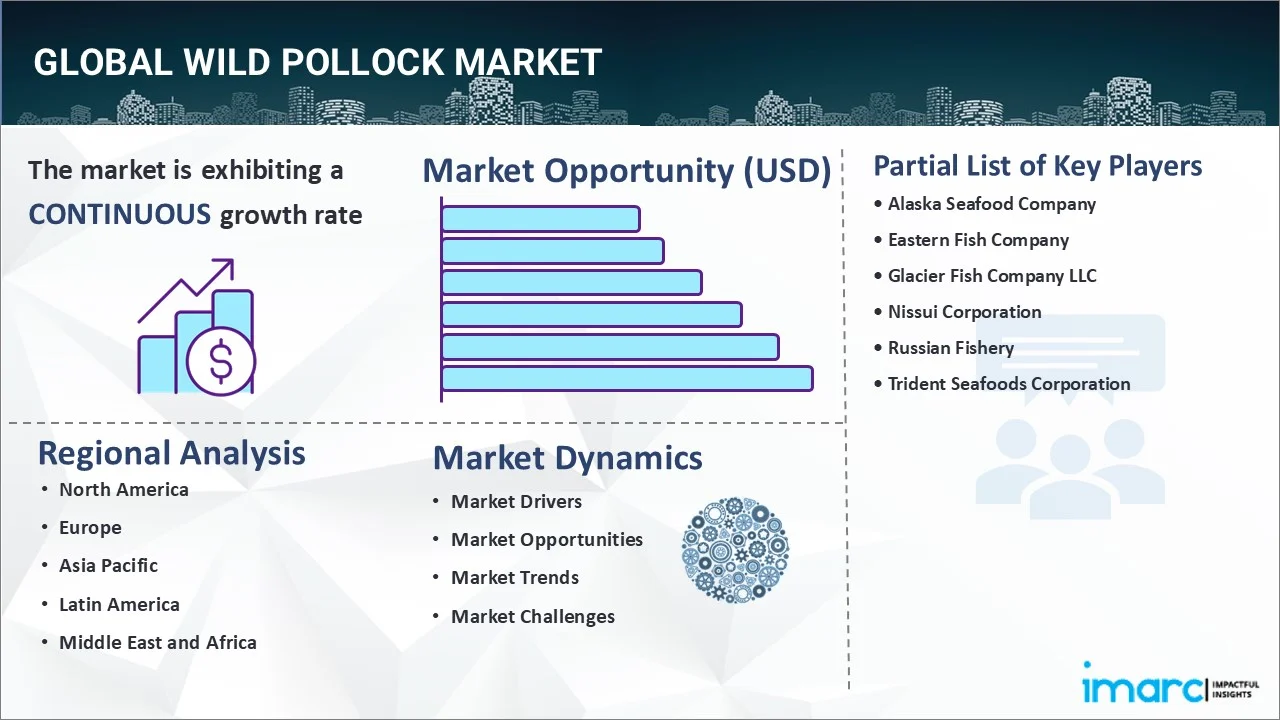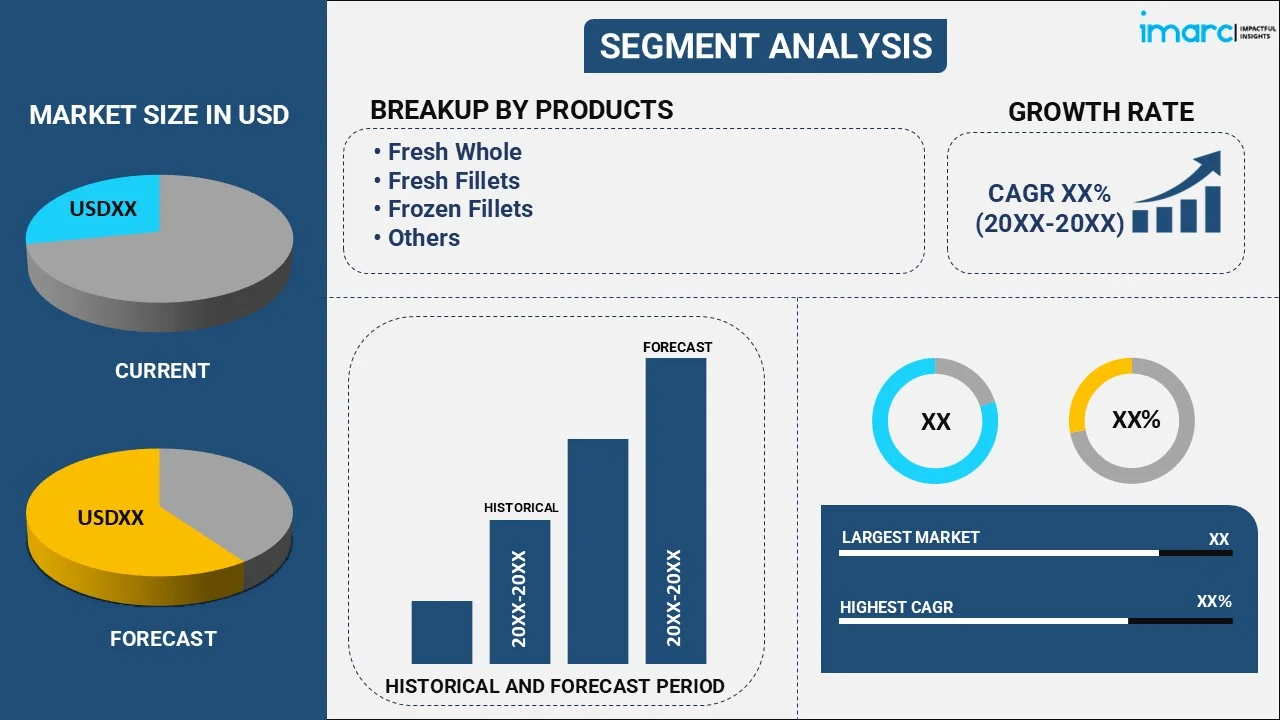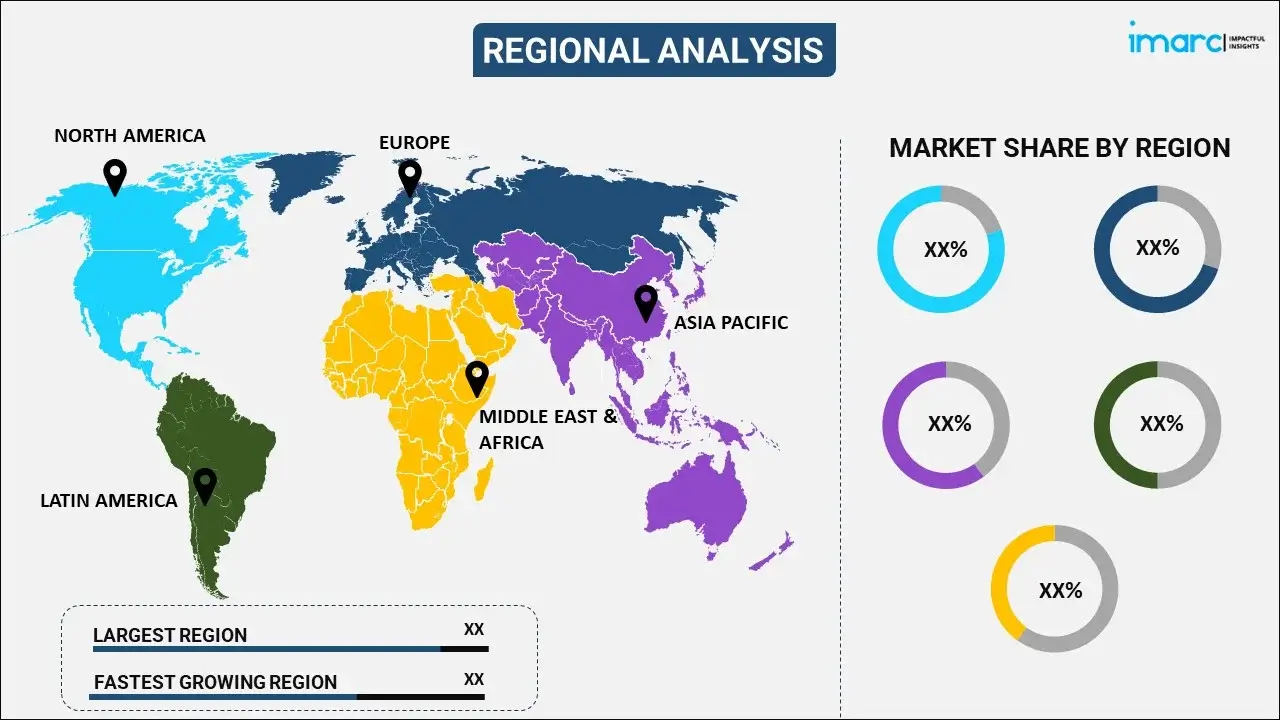
Wild Pollock Market Report by Product (Fresh Whole, Fresh Fillets, Frozen Fillets, and Others), Distribution Channel (Business to Business, Business to Consumer), End Use (Residential, Commercial), and Region 2025-2033
Market Overview:
The global wild pollock market size reached USD 2.2 Billion in 2024. Looking forward, IMARC Group expects the market to reach USD 3.3 Billion by 2033, exhibiting a growth rate (CAGR) of 4.5% during 2025-2033. The growing preference for convenience foods, particularly frozen and ready-to-eat (RTE) meals, rising demand for transparency and traceability in food sourcing, increasing awareness through digital marketing, social media, and eco-labeling initiatives are some of the factors impelling the market growth.
|
Report Attribute
|
Key Statistics
|
|---|---|
|
Base Year
|
2024
|
|
Forecast Years
|
2025-2033
|
|
Historical Years
|
2019-2024
|
| Market Size in 2024 | USD 2.2 Billion |
| Market Forecast in 2033 | USD 3.3 Billion |
| Market Growth Rate 2025-2033 | 4.5% |
Wild Pollock Market Analysis:
- Market Growth and Size: The market is witnessing moderate growth, driven by the growing demand for eco-friendly seafood options, along with the rising number of health-conscious individuals.
- Technological Advancements: Advancements in processing and packaging assist in enhancing the quality and convenience of wild pollock products, which is supporting the market growth.
- Industry Applications: Wild pollock finds application in various culinary offerings, ranging from sushi to fish tacos, catering to diverse preferences of individuals. In addition, it is utilized in processed seafood products, such as fish sticks and surimi.
- Geographical Trends: North America leads the market, driven by the rising seafood consumption among people. However, Asia Pacific is emerging as a fast-growing market due to the thriving fishing industry.
- Competitive Landscape: Companies are investing in advanced quality control measures and adhering to food safety regulations to maintain the trust of individuals and safety standards.
- Challenges and Opportunities: While the market faces challenges, such as supply chain complexities, it also encounters opportunities, such as the thriving e-commerce sector.
- Future Outlook: The future of the wild pollock market looks promising, with stringent food quality standards. The rising demand for food products with proper labeling is projected to bolster the market growth.

Wild Pollock Market Trends:
Growing Demand for Frozen and Ready-to-Eat (RTE) Meals
The increasing demand for convenient food options, particularly frozen and ready-to-eat (RTE) meals among the masses, represents one of the key factors impelling the market growth. Wild pollock is frequently used in frozen fish products like fillets, fish sticks, and breaded fish, catering to the needs of consumers seeking quick, easy-to-prepare meals. The long shelf life of pollock and its ability to retain flavor and texture after freezing make it an attractive option for manufacturers and consumers alike. Additionally, its mild taste and versatility allow it to be used in a variety of recipes, increasing its appeal. In 2023, GAPP partnered with Gorton’s Seafood to launch Wild Alaska Pollock Air Fried Fish Fillets. These fillets feature a light, crispy breading with 50% less fat and are air fried before reaching consumers, offering a healthy and convenient meal option.
Increasing Awareness Through Marketing and Campaigns
Seafood industry groups and brands are promoting the health benefits, sustainability, and versatility of wild pollock through digital marketing, social media, and eco-labeling initiatives. Campaigns highlighting the role of pollack as a sustainable and affordable alternative to more expensive fish, such as salmon or cod, are resonating with consumers. By leveraging these marketing strategies, brands are successfully elevating the profile of wild pollack, leading to higher consumer recognition and increased demand in both domestic and international markets. The Genuine Alaska Pollock Producers Association (GAPP) revealed that Chef César Perez from Food52 will be leading a live cooking demonstration at the Wild Alaska Pollock Annual Meeting on September 26, 2024. Perez will demonstrate the versatility of Wild Alaska Pollock by preparing the popular "Brothy Tomato Pasta with White Fish, Shallots & Capers." This event is a part of GAPP's efforts to increase consumer interest in Wild Alaska Pollock.
Rising Consumer Focus on Traceability
The growing demand for transparency and traceability in food sourcing is positively influencing the wild pollock market outlook. Consumers are becoming more conscious about where their food comes from and how it is harvested. They seek assurances that their seafood is responsibly sourced and meets environmental and ethical standards. Technologies like blockchain, which allows for the tracking of seafood from the ocean to the table, are becoming more prominent. Wild pollock fisheries that can provide clear information about sustainable fishing practices, origin, and supply chain integrity are gaining consumer trust, leading to higher demand for traceable wild pollock products. In 2023, the "Pollock People" campaign was introduced by GAPP in order to enhance consumer awareness about wild Alaska pollock. The initiative showcased interviews and videos with more than 20 industry officials, with the goal of emphasizing the workers in the supply chain and advocating for the sustainability of the fishery. This project aimed to establish consumer confidence through offering additional details on the sources of their food.
Wild Pollock Industry Segmentation:
IMARC Group provides an analysis of the key trends in each segment of the market, along with forecasts at the global, regional, and country levels for 2025-2033. Our report has categorized the market based on product, distribution channel, and end use.
Breakup by Product:

- Fresh Whole
- Fresh Fillets
- Frozen Fillets
- Others
Fresh whole accounts for the majority of the market share
The report has provided a detailed breakup and analysis of the market based on the product. This includes fresh whole, fresh fillets, frozen fillets, and others. According to the report, fresh whole represented the largest segment.
Fresh whole wild pollock is often sold with head, skin, and bones intact. This product category is favored by consumers who prefer to prepare and cook the fish themselves. In addition, it is widely available through online and offline distribution channels across the globe. Besides this, fresh whole wild pollock can be prepared in numerous ways, including grilling, baking, broiling, poaching, or even frying. The head, bones, and skin can be used to make flavorful stocks and broths for soups and sauces.
Fresh fillets are boneless and often skinless portions of the fish. They are a popular choice among consumers seeking convenience in cooking. In line with this, fresh fillets can be pan-fried, grilled, baked, or used in various culinary preparations, which is contributing to the growth of the market.
Frozen fillets are preserved through freezing and are widely available in supermarkets and grocery stores. They offer extended shelf life and are convenient for consumers who want a longer storage option without compromising on quality. Moreover, the rising demand for frozen food products among people with busy lifestyles is propelling the market growth.
Others include a wide range of processed wild pollock products, such as fish sticks, surimi, fish cakes, and more. In line with this, these processed products are designed to cater to diverse culinary preferences and are often found in frozen food sections
Breakup by Distribution Channel:
- Business to Business
- Business to Consumer
- Grocery Stores
- Hypermarkets and Supermarket
- Online Retail Stores
Business to consumer holds the largest share
A detailed breakup and analysis of the market based on the distribution channel have also been provided in the report. This includes business to business and business to consumer (grocery stores, hypermarkets and supermarket, and online retail stores). According to the report, business to consumer accounted for the largest market share.
Business to consumer (B2C) distribution channel focuses on selling wild pollock products directly to individuals. In addition, these products are commonly available in traditional grocery stores, making them easily accessible to consumers for in-home cooking and meal preparation. Besides this, hypermarkets and supermarkets have a wide variety of products, offering consumers a one-stop shopping experience for their seafood needs. Furthermore, the wide availability of wild pollock products through online retail platforms is supporting the market growth. People are increasingly purchasing seafood items online due to their doorstep delivery options.
Business to business (B2B) involves the sale of products directly from producers, processors, or wholesalers to other companies within the seafood industry. In addition, B2B may include supplying seafood to restaurants, seafood processors, and other intermediaries in the supply chain.
Breakup by End Use:
- Residential
- Commercial
Commercial represents the leading market segment
The report has provided a detailed breakup and analysis of the market based on the end use. This includes residential and commercial. According to the report, commercial represented the largest segment.
Commercial involves companies and food service establishments that purchase wild pollock products for preparation and serving in a commercial setting. In addition, restaurants of all types, ranging from fine dining to fast food, incorporate wild pollock into their menus to offer seafood dishes to their wide range of consumers. Besides this, caterers may use these products to create seafood platters and dishes for events and gatherings. Furthermore, hospitality establishments often feature wild pollock on their dining menus, serving guests with a variety of seafood options.
People also purchase wild pollock products for personal consumption at home. In addition, the rising demand for wild pollock among people in residential settings to cook and prepare meals in their kitchens is strengthening the market growth.
Breakup by Region:

- North America
- United States
- Canada
- Europe
- Germany
- France
- United Kingdom
- Italy
- Spain
- Others
- Asia Pacific
- China
- Japan
- India
- South Korea
- Australia
- Indonesia
- Others
- Latin America
- Brazil
- Mexico
- Others
- Middle East and Africa
North America leads the market, accounting for the largest wild pollock market share
The market research report has also provided a comprehensive analysis of all the major regional markets, which include North America (the United States and Canada); Europe (Germany, France, the United Kingdom, Italy, Spain, and others); Asia Pacific (China, Japan, India, South Korea, Australia, Indonesia, and others); Latin America (Brazil, Mexico, and others); and the Middle East and Africa. According to the report, North America accounted for the largest market share as it has huge coastlines, providing abundant access to the natural habitats of wild pollock. This proximity to wild pollock fishing grounds ensures a steady supply, which is propelling the market growth. Moreover, the growing demand for seafood products among the masses is offering a positive market outlook in the region. Apart from this, the rising consumption of protein-rich dietary choices among health-conscious people is contributing to the market growth in the region. In addition, North America has well-established distribution networks, including grocery stores, hypermarkets, and online retail platforms, making it convenient for consumers to access wild pollock products.
Asia Pacific stands as another key region in the market, driven by the rising utilization of wild pollock in several culinary applications due to its affordability is supporting the growth of the market. Moreover, the Asia Pacific region has an advanced seafood processing market, where wild pollock is used to produce a wide range of value-added products, such as surimi, fish balls, and fish cakes. In line with this, the growing adoption of responsible fishing practices is positively influencing the market.
Europe maintains a strong presence in the market due to the presence of a well-established seafood processing market, where wild pollock is used to produce popular items, such as fish fingers, fish pies, and breaded fillets. These processed products cater to different preferences of individuals. Besides this, the rising adoption of convenient and ready-to-cook seafood options among people is bolstering the market growth.
Latin America exhibits growing potential in the wild pollock market on account of the presence of a huge coastline and both the Atlantic and Pacific Oceans, providing abundant access to fishing grounds where wild pollock is widely available. In addition, Latin American countries, such as Chile and Peru, have a rich tradition of fishing and seafood consumption, which is propelling the market growth.
The Middle East and Africa region shows a developing market for wild pollock, primarily driven by the rising demand for protein-rich food sources among the masses. Moreover, the increasing adoption of wild pollock due to the thriving tourism sector in the region is strengthening the market growth.
Leading Key Players in the Wild Pollock Industry:
Key players in the market are focusing on sustainable sourcing practices. They are collaborating with organizations to obtain certification for responsible fishing, demonstrating their dedication to preserve fish stocks and ocean ecosystems. In line with this, companies are developing new wild pollock-based products, such as flavored fillets, pre-marinated options, and ready-to-cook dishes, that appeal to individuals seeking convenience food options. Furthermore, major manufacturers are ensuring product quality and safety by investing in advanced quality control measures and adhering to food safety regulations to maintain the trust of people and safety standards. Apart from this, they are adhering to regulations related to seafood sourcing, labeling, and food safety.
The market research report has provided a comprehensive analysis of the competitive landscape. Detailed profiles of all major companies have also been provided. Some of the key players in the market include:
- Alaska Seafood Company
- Eastern Fish Company
- Glacier Fish Company LLC
- Nissui Corporation
- Russian Fishery
- Trident Seafoods Corporation
(Please note that this is only a partial list of the key players, and the complete list is provided in the report.)
Wild Pollock Market News:
- February 2024: The U.S. Department of Agriculture (USDA) announced it would purchase 50 million pounds of Alaska seafood, including pollock, pink salmon, and sockeye salmon, for national food and nutrition programs. This initiative aims to assist food security efforts.
- July 2023: Hill's Pet Nutrition introduced new products in its Science Diet Sensitive Stomach & Skin line, featuring MSC-certified wild Alaskan Pollock and insect protein to support pets with sensitive stomachs and skin. These sustainable, high-quality proteins aimed to provide optimal nutrition while promoting environmental responsibility.
- August 2023: McDonald's Singapore announced the launch of its new Black Pepper Cheese Filet-O-Fish, which became available on August 31. The burger featured 100% wild Alaskan Pollock with a black pepper cheese sauce.
Wild Pollock Market Report Scope:
| Report Features | Details |
|---|---|
| Base Year of the Analysis | 2024 |
| Historical Period | 2019-2024 |
| Forecast Period | 2025-2033 |
| Units | Billion USD |
| Scope of the Report | Exploration of Historical and Forecast Trends, Industry Catalysts and Challenges, Segment-Wise Historical and Predictive Market Assessment:
|
| Products Covered | Fresh Whole, Fresh Fillets, Frozen Fillets, Others |
| Distribution Channels Covered |
|
| End Uses Covered | Residential, Commercial |
| Regions Covered | Asia Pacific, Europe, North America, Latin America, Middle East and Africa |
| Countries Covered | United States, Canada, Germany, France, United Kingdom, Italy, Spain, China, Japan, India, South Korea, Australia, Indonesia, Brazil, Mexico |
| Companies Covered | Alaska Seafood Company, Eastern Fish Company, Glacier Fish Company LLC, Nissui Corporation, Russian Fishery, Trident Seafoods Corporation, etc. |
| Customization Scope | 10% Free Customization |
| Post-Sale Analyst Support | 10-12 Weeks |
| Delivery Format | PDF and Excel through Email (We can also provide the editable version of the report in PPT/Word format on special request) |
Key Questions Answered in This Report:
- How has the global wild pollock market performed so far, and how will it perform in the coming years?
- What are the drivers, restraints, and opportunities in the global wild pollock market?
- What is the impact of each driver, restraint, and opportunity on the global wild pollock market?
- What are the key regional markets?
- Which countries represent the most attractive wild pollock market?
- What is the breakup of the market based on the product?
- Which is the most attractive product in the wild pollock market?
- What is the breakup of the market based on the distribution channel?
- Which is the most attractive distribution channel in the wild pollock market?
- What is the breakup of the market based on the end use?
- Which is the most attractive end use in the wild pollock market?
- What is the competitive structure of the market?
- Who are the key players/companies in the global wild pollock market?
Key Benefits for Stakeholders:
- IMARC’s industry report offers a comprehensive quantitative analysis of various market segments, historical and current market trends, market forecasts, and dynamics of the wild pollock market from 2019-2033.
- The research report provides the latest information on the market drivers, challenges, and opportunities in the global wild pollock market.
- The study maps the leading, as well as the fastest-growing, regional markets. It further enables stakeholders to identify the key country-level markets within each region.
- Porter's five forces analysis assists stakeholders in assessing the impact of new entrants, competitive rivalry, supplier power, buyer power, and the threat of substitution. It helps stakeholders to analyze the level of competition within the wild pollock industry and its attractiveness.
- The competitive landscape allows stakeholders to understand their competitive environment and provides insight into the current positions of key players in the market.
Need more help?
- Speak to our experienced analysts for insights on the current market scenarios.
- Include additional segments and countries to customize the report as per your requirement.
- Gain an unparalleled competitive advantage in your domain by understanding how to utilize the report and positively impacting your operations and revenue.
- For further assistance, please connect with our analysts.
 Inquire Before Buying
Inquire Before Buying
 Speak to an Analyst
Speak to an Analyst
 Request Brochure
Request Brochure
 Request Customization
Request Customization




.webp)




.webp)












